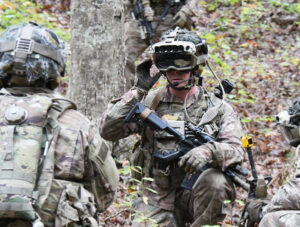The Army’s top acquisition official said the decision to place $350 million for procurement of the new Integrated Visual Augmentation System (IVAS) headset on hold in the final fiscal year 2022 defense spending bill was “good oversight by Congress.”
“I think the congressional reductions are, frankly, just good oversight by Congress,” Doug Bush, assistant secretary of the Army for acquisition, logistics and technology, said during a Defense News
discussion on Friday. “I believe the funding profile for the program assumed almost effortless progress to full production, However, as is often the case with new technology, we’ve run into issues with integrating new technologies into something that is hardened for combat. It is not a small task.”

The final FY ‘22 appropriations legislation included a $393.7 million reduction in IVAS procurement, citing the original spending request as “ahead of need.”
Lawmakers withheld $350 million of the total $405.1 million for IVAS procurement in FY ‘22 until the completion of initial operational test and evaluation (IOT&E) and after Army officials brief Congress on the status of the program (Defense Daily, March 14).
Bush said testing going now will provide valuable information for the Army leading into IOT&E this May, adding he believes IVAS is ending up on a “reasonable production ramp that matches the pace of the technology maturing.”
“We’re cautiously optimistic but we have to prove out that the system can do what we want in order to really go to full rate production with our industry partner,” Bush said.
Last March, the Army awarded Microsoft [MSFT] a deal worth up to $21.9 billion over the next 10 years to move the IVAS program from rapid prototyping into production (Defense Daily, March 31 2021).
Bush told reporters in February it’s unlikely the service will spend the maximum $22 billion allowed under its current production contract for IVAS (Defense Daily, Feb. 18).
IVAS is an example of the Army using new programmatic authorities “to the maximum effect,” Bush noted, which allows the service to pursue a more rapid program timeline.
“It’s not completely surprising that we hit some bumps. But I think we’re learning from those and applying those lessons to other programs so we can use the new authorities to go faster but at the same time manage the risk appropriately,” Bush said.